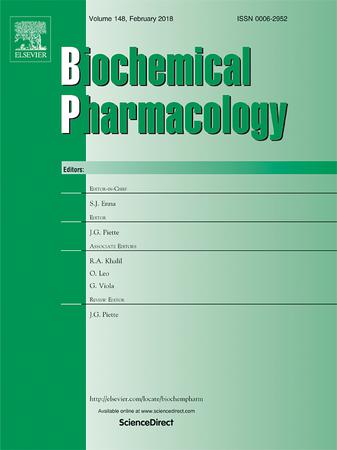发现治疗TNBC的新型BCL-2抑制剂GW806742X。
IF 5.3
2区 医学
Q1 PHARMACOLOGY & PHARMACY
引用次数: 0
摘要
三阴性乳腺癌(TNBC)缺乏雌激素受体(ER)、孕激素受体(PR)和人表皮生长因子受体(HER2),传统治疗方法无法准确靶向TNBC。蒽环类和紫杉醇类化疗药物仍是TNBC治疗的主要药物,但这些化疗药物毒副作用大,在TNBC治疗过程中容易产生耐药。在本研究中,我们研究了GW806742X治疗TNBC的疗效及其潜在的作用机制。我们筛选了600个fda批准的小分子化合物,以确定GW806742X,这是一种抑制三阴性乳腺癌细胞活力的小分子。在体外实验中,GW806742X对TNBC细胞具有剂量依赖性的细胞毒性,并在体内抑制MDA-MB-468肿瘤的生长。在机制上,我们利用PharmMapper预测了GW806742X可能的靶点,并通过分子对接模拟和ITC实验证明了该小分子药物可以直接与BCL-2结合。Western blot分析表明,GW806742X可降低BCL-2蛋白水平,并可能通过溶酶体途径促进BCL-2降解。此外,GW806742X可破坏NF-κB信号。综上所述,本研究表明GW806742X可通过靶向BCL-2成为三阴性乳腺癌的潜在治疗药物。本文章由计算机程序翻译,如有差异,请以英文原文为准。

Discovery of a novel BCL-2 inhibitor GW806742X for the treatment of TNBC
Triple-negative breast cancer(TNBC) lacks estrogen receptor (ER), progesterone receptor (PR), and human epidermal growth factor receptor (HER2), and traditional treatments cannot accurately target TNBC. Anthracycline- and paclitaxel-based chemotherapeutic agents are still the mainstay of treatment for TNBC, but these chemotherapeutic agents have major toxic side effects and are prone to drug resistance during the treatment of TNBC. In this study, we investigated the efficacy and potential mechanisms of action of GW806742X in the treatment of TNBC.
We screened a library of 600 FDA-approved small molecule compounds to identify GW806742X, a small molecule that inhibits the viability of triple-negative breast cancer cells. In vitro, GW806742X was found to be cytotoxic to TNBC cells in a dose-dependent manner and to inhibit the growth of MDA-MB-468 tumors in vivo. Mechanistically, we used PharmMapper to predict the possible targets of GW806742X and demonstrated that the small molecule drug could directly bind to BCL-2 by molecular docking simulations and ITC experiments. Western blot analysis demonstrated that GW806742X could reduce BCL-2 protein levels and possibly promote BCL-2 degradation through the lysosomal pathway. Moreover, GW806742X disrupts NF-κB signaling.
In conclusion, this study demonstrates that GW806742X can be a potential therapeutic agent for triple-negative breast cancer by targeting BCL-2.
求助全文
通过发布文献求助,成功后即可免费获取论文全文。
去求助
来源期刊

Biochemical pharmacology
医学-药学
CiteScore
10.30
自引率
1.70%
发文量
420
审稿时长
17 days
期刊介绍:
Biochemical Pharmacology publishes original research findings, Commentaries and review articles related to the elucidation of cellular and tissue function(s) at the biochemical and molecular levels, the modification of cellular phenotype(s) by genetic, transcriptional/translational or drug/compound-induced modifications, as well as the pharmacodynamics and pharmacokinetics of xenobiotics and drugs, the latter including both small molecules and biologics.
The journal''s target audience includes scientists engaged in the identification and study of the mechanisms of action of xenobiotics, biologics and drugs and in the drug discovery and development process.
All areas of cellular biology and cellular, tissue/organ and whole animal pharmacology fall within the scope of the journal. Drug classes covered include anti-infectives, anti-inflammatory agents, chemotherapeutics, cardiovascular, endocrinological, immunological, metabolic, neurological and psychiatric drugs, as well as research on drug metabolism and kinetics. While medicinal chemistry is a topic of complimentary interest, manuscripts in this area must contain sufficient biological data to characterize pharmacologically the compounds reported. Submissions describing work focused predominately on chemical synthesis and molecular modeling will not be considered for review.
While particular emphasis is placed on reporting the results of molecular and biochemical studies, research involving the use of tissue and animal models of human pathophysiology and toxicology is of interest to the extent that it helps define drug mechanisms of action, safety and efficacy.
 求助内容:
求助内容: 应助结果提醒方式:
应助结果提醒方式:


